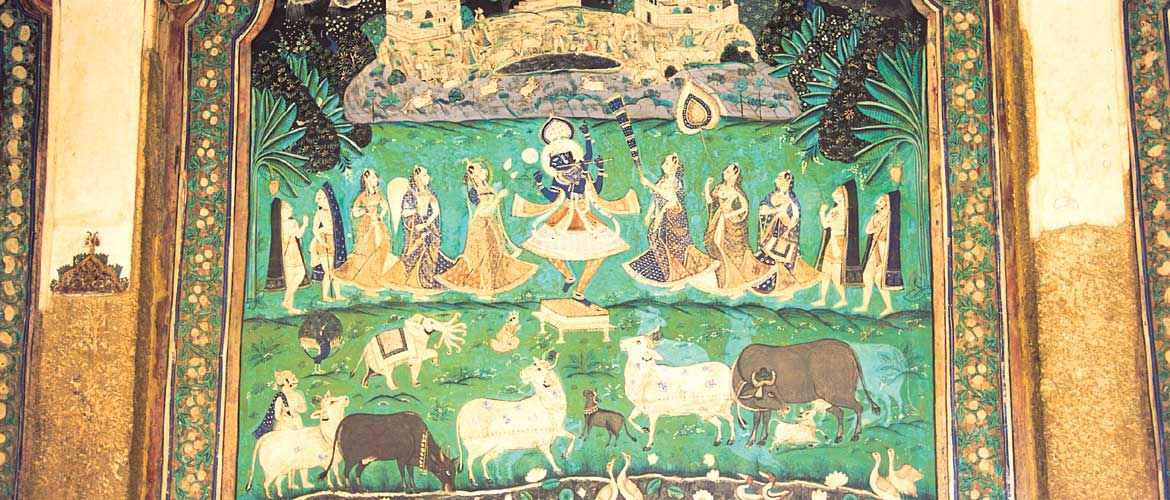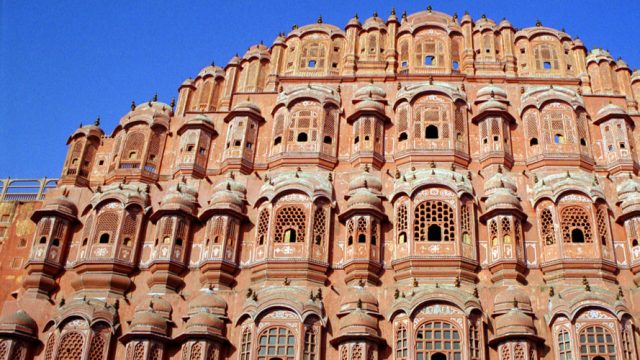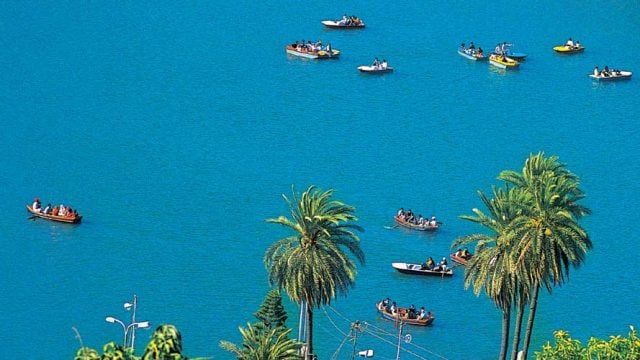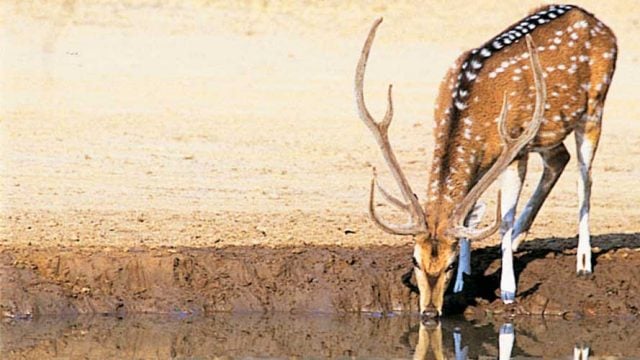Bundi is at its enchanting best in the monsoon. On a perfect day in the
THING TO SEE AND DO
It is not difficult to imagine that a Rajput royal in the 14th century searched high and low for a suitable hilltop in the Aravalli Range to build a fort. Imagine then that over the next seven centuries life flowed down the hill and spread in the valley below. This will give you a sense of the temporal-geographical spread of Bundi, and couple of meandering days will give you time enough to explore it.
The ruins of Taragarh Fort are to the north of Bundi, perched on a hill. Below, on the mountain slope, is the Garh Palace, an ensemble of mahals. Further down and towards the southwest is Nawal Sagar Lake, with Moti Mahal and havelis along its northern and eastern banks. Outside the Garh Palace, to its south, is Nahar ka Chhota, the bazaar for tourists’ daily needs.
Garh Palace
The palace was built by different kings between the 17th and 18th centuries. Unoccupied in the second half of the 20th century, it lay decaying until recently, when the potential of tourism-generated revenue inspired a clean-up and reopening. Enter through the huge and magnificent Hathi Pol into a world where local stone has been used to create jharokhas, pillars and intricately carved brackets in typical Rajput-style. The Chhatra Mahal, Phool Mahal and Badal Mahal are justly famous for their murals.
Entry Indians ₹25; Foreigners ₹100 Timings 8.00am-6.00pm Photography ₹50 Videography ₹100

Chitrashala
The Chitrashala or Ummed Mahal is part of the Garh Palace, with a separate entrance. Built in the 18th century, it is a set of rooms on a raised platform above a garden court yard, and its walls and ceilings are embellished with paintings.
Timings 8.00am-6.00pm
Taragarh Fort
Built on a 1,426-ft-high hill, this 14th-century ramshackle but grand structure does not fail to impress. Its immense bastions, bathed in the light of the setting sun, evoke a rich past and a sense of awe.
Entry Indians ₹25; Foreigners ₹100 Timings Sunrise-sunset Photography ₹50 Videography ₹100
Stepwells
Baoli, vav, kund, vapi, sagar – different bodies of water, various shades of collective lives. Bundi is famous for its 50-odd ancient wells and tanks, sources of water in a land known for its aridity. Baolis had utilitarian value and were centres of religious and social existence. The rich considered building these marvels of architecture a sacred act.
Raniji-ki-Baoli is the most famous because of its impressive architecture with arches and pillars and beautiful orna mentation. Commissioned by Rani Nathvatiji in 1699 (she is reputed to have built 20 other baolis too), this is the most well-maintained baoli.

Dhabhai Kund (south of Ranijiki-Baoli) creates a fascinating geometry with its steps and deserves a visit despite its abysmal state. A pair of matching step wells (just outside Chogan Gate) are called Nagar Sagar. The 16th-century Bhoraji-ka-Kund (north of Nawal Sagar) is impres sive and attracts birdlife post-monsoon.
Other Sights
The Nawal Sagar is an 18th-century lake with a temple of Varuna, the god of water, presiding at the head of Bundi just below the Garh Palace. To the northeast of the town is the lake Jait Sagar, on which stands a small palace called Sukh Mahal, famous for once hosting Rudyard Kipling. On the other bank of the lake is Kshar Bagh, the final resting place for Bundi’s royalty, with some beautiful cenotaphs built between the 16th and 19th centuries. The door is usually locked but check at the nearby houses and someone will have the key to the place.
The finest cenotaph in Bundi is to the south of the town, the Chaurasi Khambon ki Chhatri (the 84-pillared cenotaph). This artistic 17th-century creation is a two-storeyed structure on a high plinth and is stunning when lit up at night.
Shikar Burj (8 km northwest of town) was a hunting lodge next to a water tank, and is now a picnic haunt for nearby villagers.

WHERE TO STAY AND EAT
Bundi Vilas (Cell: 09414175280; Tariff: ₹5,600-6,000) is a restored 300-year-old heritage haveli close to Garh Palace, with tasteful rooms.
The Haveli Braj Bhushan jee (Tel: 0747-2442322; Tariff: ₹3,500-6,800), in Balchand Para, is a 250-year-old building that has been converted into a hotel. The hotel also has a vegetarian restaurant.
RTDC’s Hotel Vrindawati (Tel: 2442473; Tariff: ₹900-1,300) is invitingly situated opposite Jait Sagar, just outside town. Kasera Paradise (Tel: 2444679; Tariff: ₹1,500-3,000) has a great rooftop terrace. The newer Hadoti Palace (Tel: 2443333; Tariff: ₹3,500-7,500), with 42 rooms, restaurant, swimming pool and a vintage car museum, is also a nice option. Haveli Katkoun (Tel: 2444311; Tariff: ₹1,200-2,500) is a homely and clean budget choice.
There are no good stand-alone restaurants in Bundi, and many hotels cater only to their in-house guests. Ishwari Niwas has decent north-Indian food and some Rajasthani dishes. Some of the dishes you can try out include malai kofta, mutton do pyaza and gatte ki subzi. Haveli Braj Bhu shanjee serves breakfast and dinner only to their resident-guests. The lunch here is a Rajashani thali. Kasera Paradise’s rooftop restaurant, Out of the Blue, serves good Italian cuisine. Bundi Inn serves decent Indian and Continental cuisine.
When to go October to March is pleas ant, as is July to August, when it rains Location A small town of medieval origin, Bundi is set in a narrow curvaceous valley in the Aravalli Hills in southeast Rajasthan Air Nearest airport: Sanganer, Jaipur Rail Nearest rail: Kota Junction
Baoli
Bhoraji-ka-Kund
Bundi





